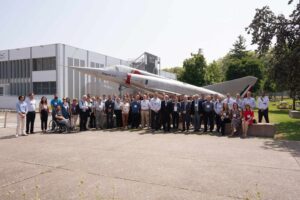An aircraft capable of crossing oceans and weighing only 25 pounds may seem unlikely, but this is exactly the proposal of a team of researchers from France, as released by Agency FAPESP. The Mermoz drone may be the first unmanned aircraft to cross oceans, with the capacity to travel up to 3,200 kilometers without breaks.
The design of the electric propulsion drone is inspired by Albatroz’s flight techniques, a bird that “hitchhikes” in atmospheric turbulences to travel up to almost a thousand kilometers a day. This technique allows birds to reduce effort and save energy.
The project is developed by researchers and students from the Higher Institute of Aeronautics and Space (Isae-Suparo), Toulouse. The idea is that the aircraft repeat the historic feat of the rider Jean Mermoz who, in May 1930, held the first commercial crossing of the South Atlantic. The flight was made by the Airpostale airline, starting from Saint-Louis, Senegal, to Natal, Rio Grande do Norte, marking a significant advance in the aviation of the time.
Unmanned electric aircraft currently in operation have limited range and autonomy due to the low energy density of lithium batteries. Therefore, in this new project, researchers intend to use hydrogen fuel cells, a clean energy source that can contribute to the decarbonization of the global energy matrix.
Hydrogen x Lithium
Hydrogen fuel cells offer several advantages over lithium batteries, some of them are:
- They provide about five times more energy per flight hour for the same weight.
- Have greater operational reliability.
- They demand less maintenance than internal combustion engines.
These characteristics make the drone promising for commercial, civil and military applications, as it can fly for long periods, with low noise level and without the need for frequent landings.
Challenges
One of the main challenges in the use of hydrogen cells is the heat dissipation generated during the process. To overcome this limitation, the researchers have developed a prototype that uses liquid hydrogen, which also contributes to expand the autonomy of the aircraft.
The drone will be equipped with a satellite communication system, allowing the loading and updating of routes according to the weather conditions.
This makes it possible to carry and update the route according to different weather conditions
Nikola Gavrilovic, postdoctoral student at Isae-Suparo, in an interview with FAPESP agency.











